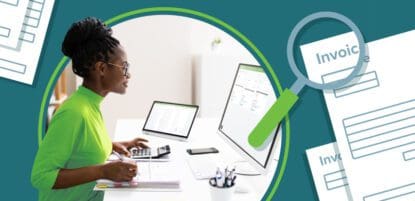Accounts payable end-to-end process
Every accounts payable (AP) process consists of at least four steps–invoice capture, invoice approval, payment authorization, and payment execution. Unfortunately, many organizations do not have an efficient AP process in place, which can result in late or missed payments, mismanaged cash flow, and weakened supplier relationships.
In this blog, we review the end-to-end process of accounts payable and discuss how an automated AP process can streamline invoice-to-pay operations.
What are the challenges in the AP process?
For many businesses, there are still big challenges in managing their AP workflow, including the following:
- Wasted Time and Resources
- Payment Fraud
- Duplicate Payments
- Strained Vendor Relationships
- Hybrid Offices
Let’s take a closer look.
Wasted time and resources
Processing a paper check includes both hard and soft costs, making the price per payment much more expensive. And not only that, but the process typically involves collating back-up documents, laser printing, signing checks, and stuffing envelopes. However, paper checks also cost companies in terms of employee effort and time.
BrightView Health, a company providing outpatient medication-assisted treatment, received 65-80% of its invoices via mail before implementing an automation solution. Each invoice would take 5-7 minutes to manually process. When BrightView’s invoice number skyrocketed to 10,000 a month, they needed a solution that would make the process more efficient. They partnered with MineralTree and were able to reduce their entire process to mere minutes.
An automated end-to-end process can help teams scale their efforts. In fact, 61% of surveyed companies noted that they can process more invoices with the same size team after switching to an automated process.
Payment fraud
95% of businesses have experienced employee theft. Additionally, when companies issue paper checks, they are giving access to their bank account information, which can lead to further instances of fraud. Organizations lose 5% of revenues to fraud globally, or more than $4.5 trillion annually.
Duplicate payments
When invoices are received in different formats or when there are different offices processing invoices, it can be easy to pay invoices twice. These duplicate payments can cause bottlenecks in the AP process, while hurting strategic partnerships with vendors.
Strained vendor relationships
58% of finance leaders note that their relationships with vendors have become more strategic over the last year. An efficient accounts payable process can help maintain these vital relationships through consistent, on-time payments. However, the inverse is also true and issues such as overdue payments or lack of transparency can frustrate your suppliers and potentially lead to delayed delivery of goods and services.
Hybrid offices
Due to the pandemic, many offices have entered either a hybrid or fully-remote model. For companies that haven’t adopted an automated end-to-end AP workflow, this new reality can have negative effects on the payment process. For instance, a controller for a healthcare non-profit was forced to go into the office at night during the pandemic in order to continue cutting paper checks. With anecdotes like this, it’s no surprise that 58% of survey respondents agree or strongly agree that the pandemic was a catalyst for their team to digitize their financial function.
What is the accounts payable process? 5 steps
The first step toward managing accounts payable more efficiently is gaining an understanding of the end-to-end AP process. The accounts payable process is responsible for paying suppliers and vendors for goods and services purchased by an organization. This involves handling incoming bills and invoices and paying them on time and via the right payment method to ensure a positive relationship with suppliers.
As discussed, every accounts payable process can be broken down into four primary steps: invoice capture, invoice approval, payment authorization, and payment execution. We’ve added one more step to this process–analytics and optimization–with the goal of overall process improvement. Here we examine each of these five steps, describing the challenges posed by manual invoice management and the benefits realized by implementing automation.
Step 1: Invoice capture
When a third-party provides a service for your company, an invoice arrives via email, mail, fax, or through a website portal. Once the invoice is received, it is then coded into the accounting system through a process called invoice capture. Invoice capture is the process of collecting data from an invoice and entering it into an ERP system. From there, it may be matched against the purchase order (PO) and pushed directly to payment — if it falls within acceptable thresholds. For non-PO invoices, the record is created when the AP department receives the invoice.
Traditionally invoice capture is a manual process, which leaves room for error and can also slow down the entire AP process — particularly if there are issues matching invoices with purchase orders. But if companies utilize an AP automation solution, invoice header and line-level details are automatically captured and invoices are automatically routed for approval based on predefined business rules. Details such as line items, amounts, and coding are instead automatically extracted using optical recognition technology, confirmed through a human review step that brings accuracy up to 99.5%, and then posted back to the ERP. These systems can also identify and resolve issues with PO matching.
Step 2: Invoice approval
Next, the invoice must be matched against the PO. If it matches, it goes straight for payment. If it doesn’t, it goes through an exception handling workflow where discrepancies are resolved prior to payment authorization. Non-PO invoices follow a typical approval routing workflow. In this scenario, the invoice needs to make it to the individual or business unit that received the product or service. The role of that individual or unit is to verify receipt of the product or service and determine that a payment date can be set.
Routing the invoice to the proper individual often occurs via email. However, it may be unclear to the AP department who the proper person is to sign off on it, which means many invoices travel through multiple people before landing in front of the right set of eyes. This can cause significant delays.
Instead, by automating the invoice approval workflow, invoice approval requests make it to the right people much faster. Not only that, but automated reminders eliminate the need to chase down forgotten approvals. Simply send approval requests with the invoice attached as a reference to approvers who are predetermined based on vendor and invoice amounts or other routing logic based on existing policies.
Step 3: Payment authorization
After invoice approval, the next step is payment authorization. In most cases, businesses will categorize invoices based on their priority and payment deadline. Once that has been completed, a batch of invoices with priority status are sent along for payment authorization. But for this to happen, the invoice needs to make its way to the finance team and the individual responsible for authorizing payment. Again, when handled manually, this can mean an email or physical documentation gets passed around for a while before finding its way to the CFO or controller for review and authorization.
With AP automation, you can easily queue up a payment batch and then submit it to the right person for authorization and further streamline the process by enabling approval and payment scheduling based on current cash management policies. This can even be set up to work from any device, which is convenient if the authorizer is traveling or on vacation with limited email access. Moreover, built-in internal controls, such as segregation of duties and dual approvals above certain thresholds, help prevent fraud.
Step 4: Payment execution
Finally, after the individual or unit who received services approves the invoice, and the finance department authorizes payment, that payment can actually be made. Depending on the AP department’s processes and the vendor’s preference, payment may be sent via check, ACH, virtual card, or another method.
Manual handling of payment execution often leads to missed due dates–particularly if this process involves paper checks or follows manual handling of the capture, approval, and authorization steps as well. This can lead to unhappy vendors, extra work if the vendors call with follow-up questions, and can cause the company to lose out on the early-pay discounts many vendors offer.
In contrast, automation makes instant payment execution possible. Authorized payments are sent out immediately or on a scheduled date, and two-way sync closes invoices in the ERP system. MineralTree’s AP automation solution even pays each supplier using their preferred payment method and continuously optimizes your payment mix by leveraging faster, cost-effective ePayments, enrolling new and existing suppliers, and managing day-to-day supplier inquiries.
Step 5: Analytics and optimization
This fifth step involves taking a closer look at internal processes to understand what’s working and what isn’t and weighing vendor relationship management with the organization’s own fiscal priorities. Ultimately, you’re looking for ways to streamline the end-to-end AP process, reduce costs, strengthen supplier relationships, and better manage your cash flow.
Manual handling of the four steps described above increases the chance of errors, slows down processes, and limits visibility and control. The right AP automation technology solution, however, not only minimizes those issues but makes it possible to harness the data generated by digitizing your AP process to instantly analyze performance, without manual manipulation. This, in turn, allows organizations to make data-driven decisions in alignment with strategic business objectives.
Automation allows organizations to replace manual, static reporting with AP reporting tools and real-time dashboards that visualize metrics and KPIs such as invoice aging, payment mix, and rebates––across operating units, locations, and suppliers. A leading AP automation solution will also make it easy to manage and monitor invoice processes and identify any invoices that need special attention.
Other considerations in the end-to-end AP process
There are a number of other factors and considerations that can affect the efficiency of your AP process. Is your company still using paper checks to make payments? This can cause manual errors and the potential for duplicate payments and even fraud. Are you implementing internal controls? These are essential, but of course, can make the process even more lengthy depending on the size of your company. How is the relationship you have with your suppliers? Having an inefficient AP process that results in late payments can tamper this relationship and potentially delay the shipment of supplies.
It’s important to be aware of the different factors that could be affecting your AP process and identify areas for improvement. If you’re dealing with any of the challenges associated with manual processes, implementing an AP automation platform that streamlines this process could be worthwhile.
Improving the accounts payable process with AP automation
To summarize, manual AP processes are expensive, time-consuming, prone to fraud, and potentially damaging to supplier relationships. In addition, inefficiencies and continued reliance on paper checks lead organizations to miss out on early-pay discounts, rebates, and other savings opportunities.
By automating the five steps of the AP process in an end-to-end solution, businesses can address the challenges presented at each step of the manual process.
For example, the risk of human error disappears when invoice data is automatically extracted during Invoice Capture and then synced with your ERP system, without any manual input. If your business uses purchase orders, an AP automation solution can even automate the matching process, using an algorithm to compare invoice line items against the PO and flag any exceptions.
MineralTree’s TotalAP solution automates your end-to-end AP process, from invoice capture to invoice payment, helping you gain efficiency at each step while supporting specific user needs from AP staff to the CFO.
TotalAP eliminates manual data entry by automatically capturing invoice details, streamlines invoice approval and payment authorization by routing invoices quickly to the right people, and continuously optimizes payments. AP analysis features also allow organizations to make better decisions faster.
The benefits of TotalAP include:
- Increased efficiency
- Simplified reconciliation
- Improved supplier relationships
- Fraud and risk mitigation
- Improved visibility and control
- Maximized cost savings
Learn how MineralTree can help your organization automate and streamline the entire accounts payable process today.
End-to-end AP FAQs
What is the end-to-end process in accounting?
The end-to-end process in accounting involves these four steps, invoice capture, invoice approval, payment authorization, and payment execution. In some cases, there is a fifth step that involves analytics and optimization of the existing process.
How to explain the end-to-end process of accounts payable?
The end-to-end process of accounts payable can be described as the process of receiving and approving invoices. From there, the invoices are sent for authorization and payments are executed.
What does the AP process start and end with?
The AP process starts with receiving an invoice from a supplier and finishes when the invoice has been paid.




